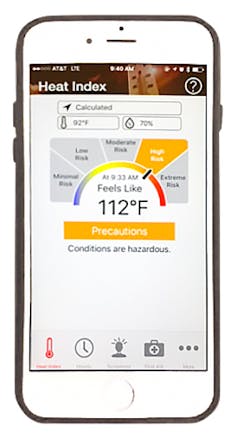The Occupational Safety and Health Administration (OSHA) is turning up the heat on employers to better protect their workers from heat-induced illnesses. OSHA announced its new workplace heat agenda in September, laying out a series of actions already begun and in the planning stages to bring more attention to the issue of workplace exposure. The initiative spans stepped-up inspections and complaint follow-ups, targeted interventions, increased research, and the crafting of a new workplace heat standard — all combining to presumably better shield workers from an often overlooked and possibly growing danger (Figure).
Quoting U.S. Department of Labor Secretary Marty Walsh, the OSHA release stated: “Throughout the nation, millions of workers face serious hazards from high temperatures both outdoors and indoors. Amid changing climate, the growing frequency and intensity of extreme heat events are increasing the dangers workers face, especially for workers of color who disproportionately work in essential jobs in tough conditions.”
Given their work environments, construction industry employers are among those squarely in OSHA’s crosshairs. As might be expected, they’re watching developments with great interest. Representing construction contractors, Associated General Contractors (AGC) said in September that it was waiting to see what would develop, but that it would likely still be opposed to the creation of a federal heat standard for workplaces. AGC testified before a congressional committee hearing in 2019, saying then that a federal standard “is not a viable approach,” and that instead, “OSHA should continue to increase awareness by working with the regulated community to further promote its Heat Illness Prevention campaign (in place since 2011) and build on the success of their past efforts.”
National Electrical Contractors Association (NECA) says it plans to submit comments when the proposed rulemaking comment period opens. Safety director Wes Wheeler says OSHA’s proposed rules are of interest to contractors, as is a separate proposal to address heat exposure in the ANSI/ASSP A10 Committee for Construction and Demolition Operations.
“It will be interesting to see how responsive OSHA’s Advisory Committee on Construction Safety and Health and the construction industry is to these proposed guidelines,” Wheeler says.
Random polling of a few electrical contractor executives revealed concern with the issue of worker heat exposure but reticence about regulatory overreach.
Citing OSHA’s intention to ratchet up inspections and interventions when the heat index reaches 80°F, Daniel Oberlies, director of risk management and human resources for O'Connell Electric Co., Inc., Victor, N.Y., worries the agency is heading toward a one-size-fits-all approach that doesn’t reflect reality. Because people respond differently to a given temperature (based on factors like acclimation, body chemistry, conditioning, underlying health, and work intensity), establishing an actionable heat reading that protects the most vulnerable worker might amount to overkill, he says.
“Some people are able to work in high temperatures easily without it bothering them, while others might be at risk in mid-range temperatures,” says Oberlies.
He contrasts that with guidelines for noise exposure to protect people from hearing damage. Unlike decibel levels that can be reliably linked to such damage for anyone, temperature exposure risk involves too many variables.
“There’s a lack of a dose-response relationship with temperatures,” he says. “There’s data showing hearing loss at certain levels. Heat doesn’t work that way.”
Paul Stone, senior site safety manager and training director for Haugland Group LLC, a Melville, N.Y., construction services conglomerate whose holdings include electrical specialist Haugland Energy Group, says he thinks OSHA is right to give heat exposure more attention but probably wrong to establish a hard-and-fast action threshold.
“I never would put a number on heat stress prevention,” he says. “The most surprising thing to me is targeting 80°F because individual tolerance levels are so different.”
That heat index reading, says Glade McInnis, president of McInnis Electric, Byram, Miss., is “unreasonable” because it is routine “from April to October around here.” The company pays close attention to heat exposure, but “we don’t worry about it until it’s in the 90s and exposure is extended.”
A better strategy, contractors say, is continuing to raise awareness of heat dangers and remedies to lower risk. Cory Borchardt, senior vice president of operations at Houston-based Fisk Electrical Co., says more regulations might only complicate ongoing and evolving efforts to ensure safe work regardless of temperature.
“I would support an education campaign over developing regulations that take years for the industry to understand how they can comply with them,” he says.
Fisk, Borchardt says, is primarily focused on risk awareness and training that leads to adjustments during heat extremes, such as work-hour changes, provision of cooling vests, fans, sunshades, breathable PPE, and more hydration stations offering high-electrolyte drinks.
At Haugland, the emphasis is on real-time monitoring of conditions that could lead to heat-induced impairment. Stone says foremen have begun using an OSHA-NIOSH heat safety tool app that guides interventions based on heat readings (Photo).
Oberlies says O’Connell also emphasizes situational awareness that involves peer checks and watching for signs of heat stress and ready provision of hydration and breaks when it’s obvious that heat danger is present.
“It’s important to focus on things that are visually apparent and tangible and doing things that can have an impact that don't involve a lot of discernment,” he says.
Read OSHA's proposed rule posted on October 27, 2021. You can also submit comments on or before December 27, 2021 at www.regulations.gov.
Tom Zind is a freelance writer based in Lees Summit, Mo. He can be reached at [email protected].
About the Author
Tom Zind
Freelance Writer
Zind is a freelance writer based in Lee’s Summit, Mo. He can be reached at [email protected].


